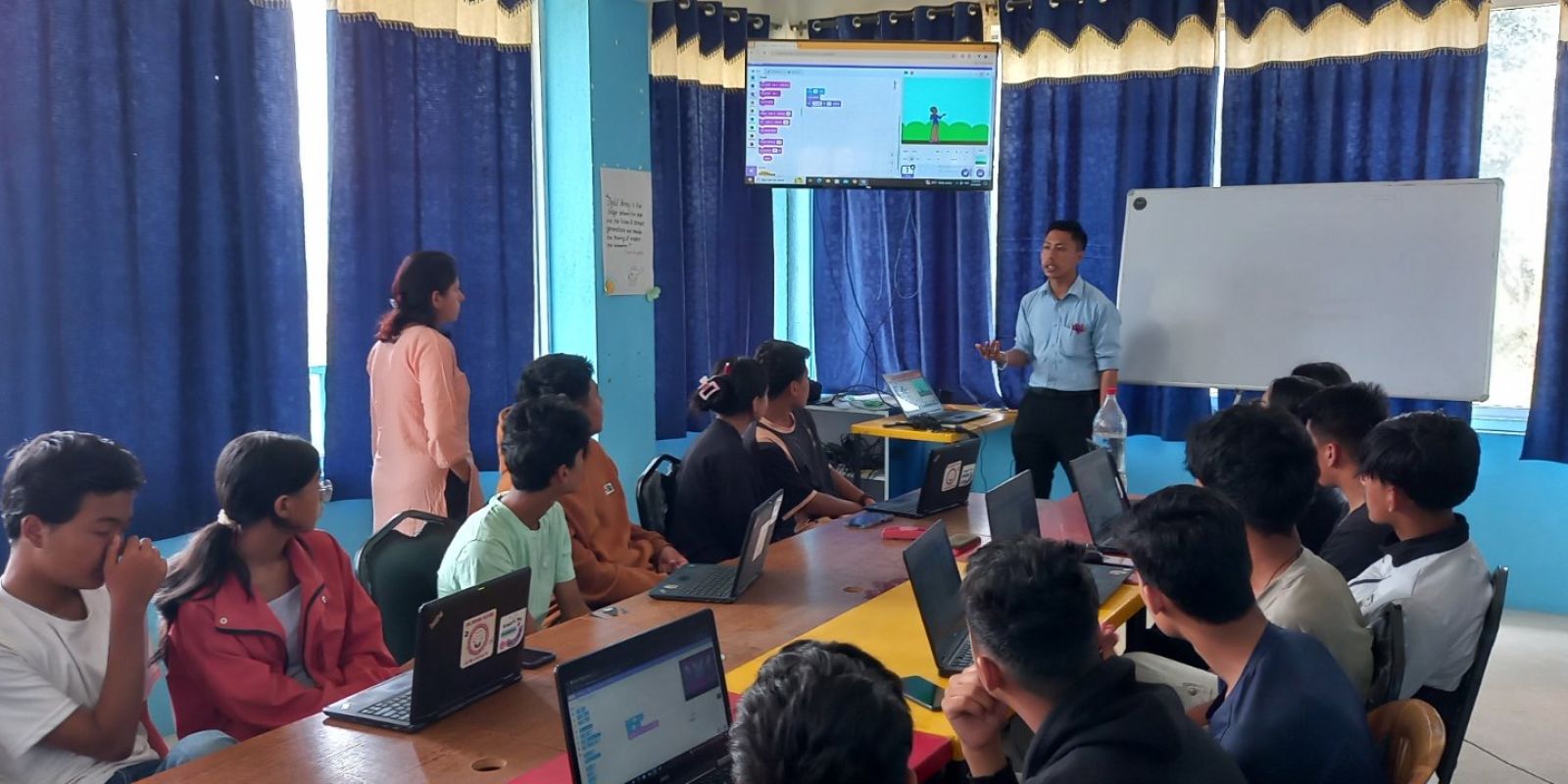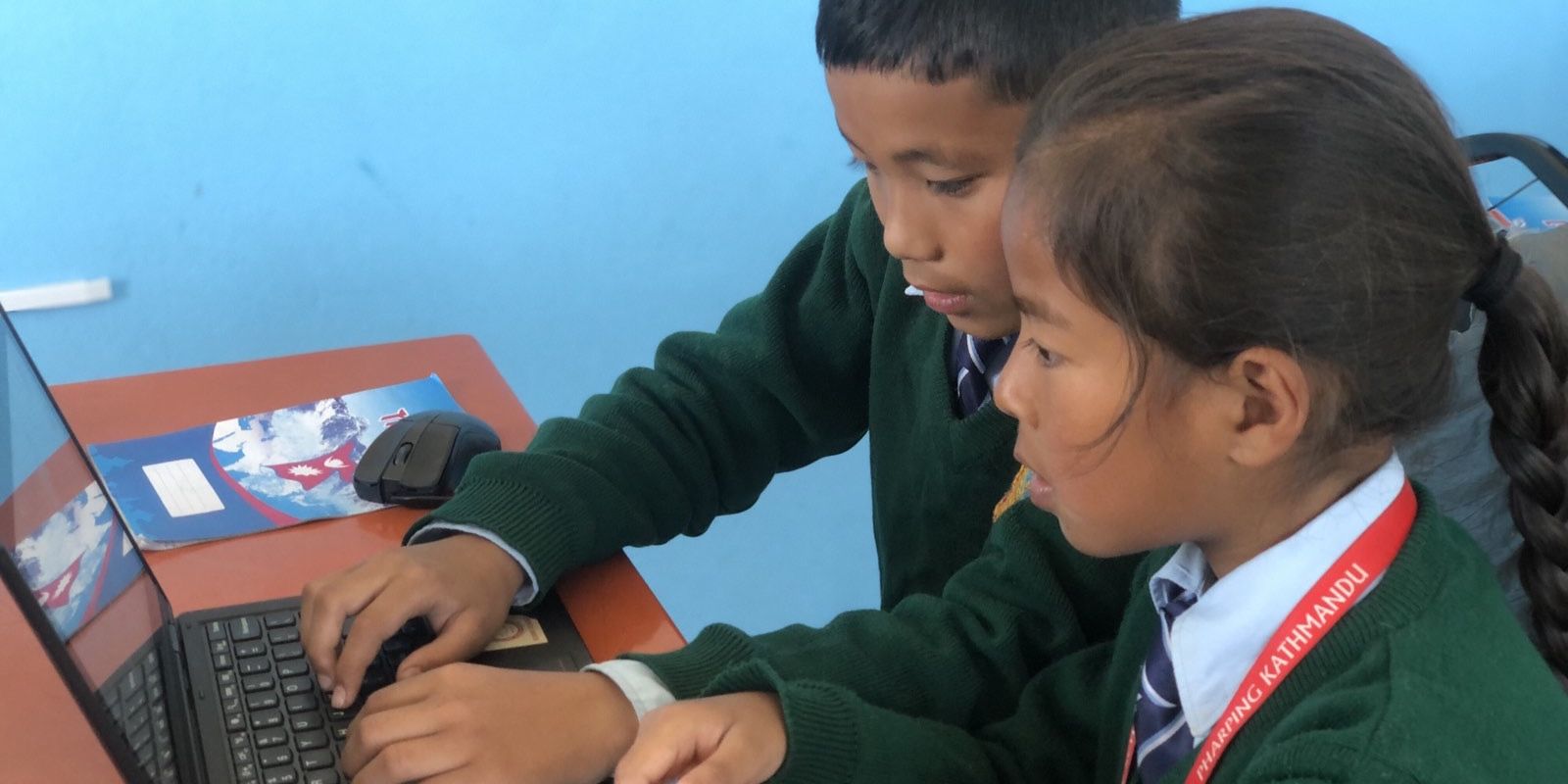Challenges Scratch Educators Face in Nepali Public Schools
Language barrier for students

Students don’t listen to teachers when immersed
Mr. Ramesh has given time to recall activities from last class. The students seem engaged in building things and many don’t seem to be engaged in recalling. The projects they work on are boys playing football, scuba diver in the pool etc.
During the lesson on Sensing things, the teacher begins the lesson by explaining the x and y coordinates. Most of the students are engaged with their own projects. Only Samyam is responding. After explaining for some time, Mr. Ramesh asks “So did you understand a little about x and y?” Most students are engaged in making their own projects. Some students are partially following the instructions Mr. Ramesh gives, while also making their own stuff.
Delivering differentiated learning experiences
The students were at their computers, busy working on their projects. HIma, as usual, was busy moving between the stations, helping students debug their projects. A few students are out of their seats, and one of them is Samyam. He says that he has already completed his story and thus doesn’t have anything to do. He moves in and out of the class with a pingpong bat and ball in his hand. He calls Mr. Ramesh to come and see his project but Hima, busy with helping students, declines. having nothing to do, he is playing with Supreme and Ashu. Them jumping around and shouting is disturbing the class.
Mr. Ramesh finally loads Scratch for the girl who had been waiting for the computer to boot. She asks her if she knows how to do the things he taught earlier in the class. The girl nods but it doesn’t look very convincing. He tells her to do things shown on the screen and leaves to look at other groups.
Some students like Manish, sitting in the front row, are playing with sounds. He had completed his work early and didn't have anything to do since. Mr. Ramesh didn't address his project as he was busy troubleshooting other students’ works.
Tech issues
A girl calls Mr. Ramesh from the back row for help but Mr. Ramesh is busy troubleshooting Rajesh’s mouse problem. When Mr. Ramesh reaches the girl’s station, she shows him a weird problem with her keyboard. Some of the keys seem to have become mismatched. “When I press the G key, D is typed on screen,” she says. Mr. Ramesh seems baffled, but we soon figure out that the keyboard’s setting was somehow changed. Reverting it back to US style solves the problem.
One girl's computer isn't booting. She seems stuck with it. She calls a friend for help and when that doesn’t work, she calls Mr. Ramesh for help. Mr. Ramesh takes a look at the computer and suggests that she work on a different computer. As he doesn’t have an in-depth knowledge of computers, he often struggles in troubleshooting the issues students face with the hardware.
Another problem that’s not much addressed is that of the monitor. These displays in the school aren’t optimized for students’ eyes and are often too bright. The resolution isn’t very good and often puts strain on the eyes. The new high contrast blocks have been immensely helpful in this regard. These aren’t the default blocks though, and students don’t switch to them unless the teacher spots them struggling and makes the switch.
Diversity of student projects

Students are constantly asking for help, with pleas for sir, sir. Mr. Ramesh struggles to give time to everyone requesting for it.
Mr. Ramesh spends too much time with individual students. He goes to help some student and gets immersed there for up to 10 minutes. One time he’s working with a student in the front row. There's a call from Samyam but he doesn't seem to hear.
“It’s difficult for me to approach all of them together,” says Mr. Ramesh to me in the middle of two columns.
“Sir please come here!” These cries for help grow more frequent. Mr. Ramesh seems engaged in one-on-one troubleshooting sessions with students, and often ignores calls from other students until he is done with a particular student. He has to move around a lot, explain things repeatedly(intro to scratch)
Towards the end of class, Mr. Ramesh is giving more answers to students compared to the initial part of the class, where he was actively scaffolding. Meanwhile students continue to show their projects to Mr. Ramesh, and to ask him for help. Aayushman shows his project where characters are standing beside a lake and are having a conversation. Mr. Ramesh says that one of the texts ended quickly and he wasn’t able to read it. He tells Aayushman to increase the time for it, and eventually enters 5 in the sec block for him. “You need to keep checking and rechecking your project,” he tells the students as a tip to debugging and improving their project.
“If I tell students to create their own stories(in Scratch) there’s too much variation [to manage.] But if I tell them to make something very specific, it’s a lot of restriction again. I must teach them individually.” Mr. Ramesh articulates his dilemma. When he lets students create projects of their own choice, he often gets bombarded with requests for help for their project. This makes it difficult for him to instruct the students collectively as each student has a different challenge as they are at different stages. But if he gives a common prompt, then there’s too much restriction. Thus he prefers to teach them individually.
Students misuse internet access
Passive engagement of students

Not knowing things they are expected to teach
It’s important for teachers to prepare well for these lessons. During the pilot lessons, we observed that the quality of the lessons delivered by the teachers was directly related to the amount of preparation they did for the lessons. Teachers who explored Scratch, went through the resources and planned their lessons were at much ease in the class. The teachers who hadn’t prepared much found themselves to be unsure, confused and hesitant to facilitate the lessons.
We recommend that a teacher new to Scratch spends 4-5 hours in preparation for a 90 minute class. Because these classes usually take place once a week, we believe that making time for preparation should not be a problem. Please remember that the quality of scaffolding you can provide to your students depends on your understanding of the concepts and tools. Preparation for the teachers means studying the lesson plan, student guide, engaging with the activities students will be doing during the lesson, and reading the educator guide to understand the challenges and possibilities during a Scratch lesson. An experienced teacher might need to give 30 mins to an hour in preparation for a 90 minutes class.
This article captures our experience of piloting Scratch in three public schools in Lalitpur through the support of the Scratch Foundation. The 72 students participating in the pilot were between ages 8 to 11 years old.
By Sameer Prasai
Sameer is a researcher & learning resource designer at Karkhana Samuha.